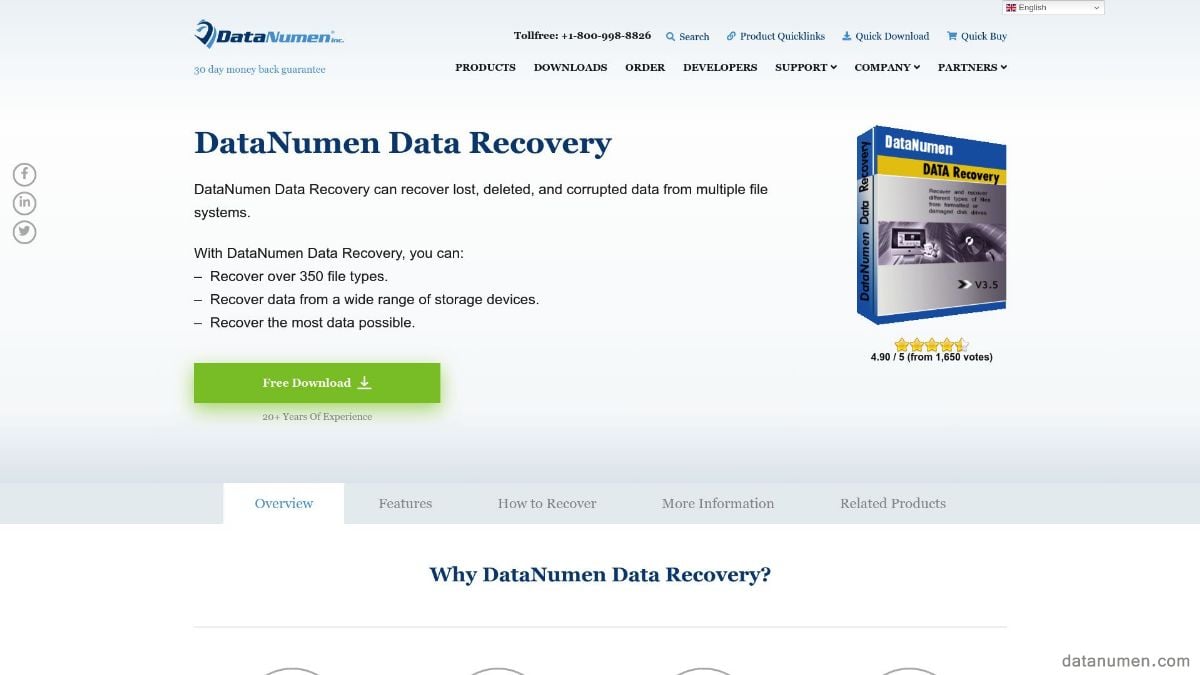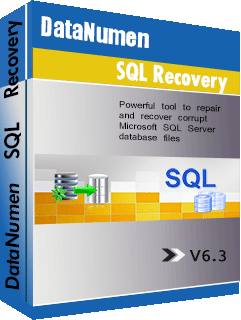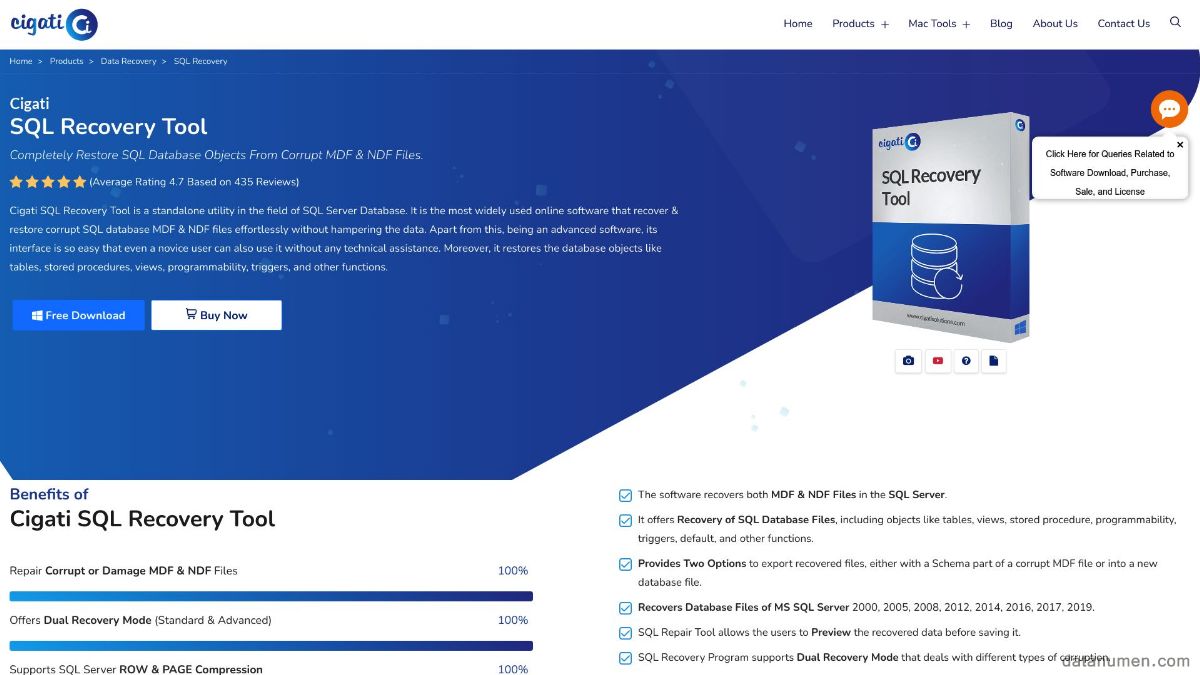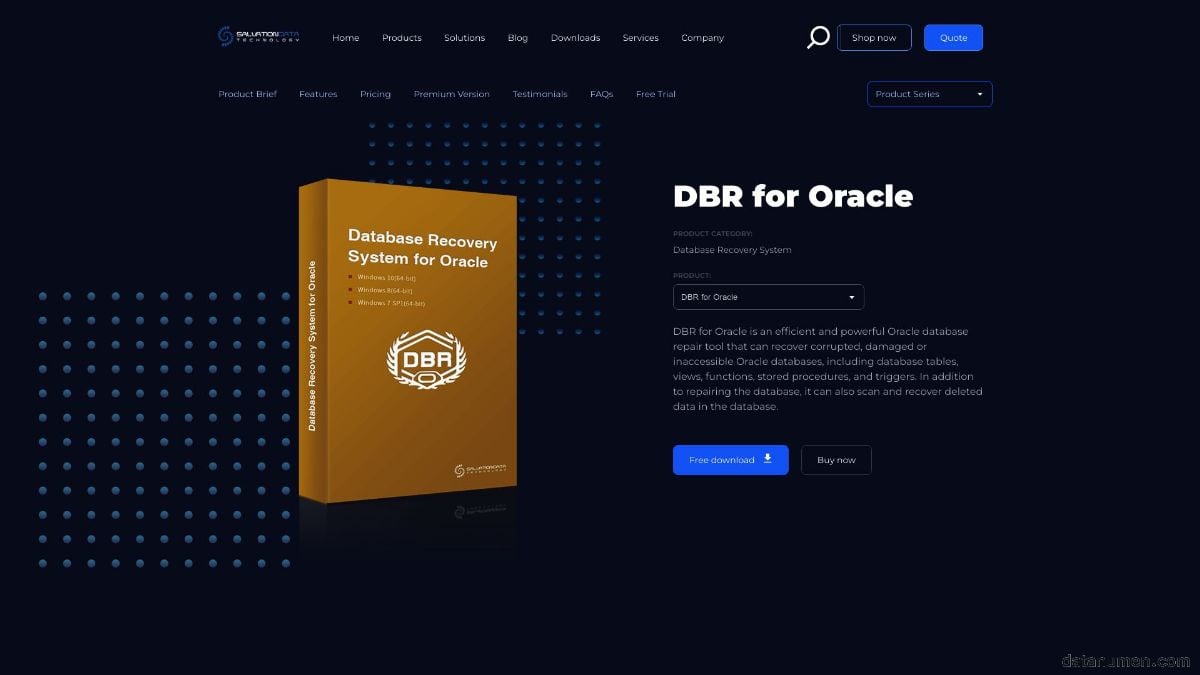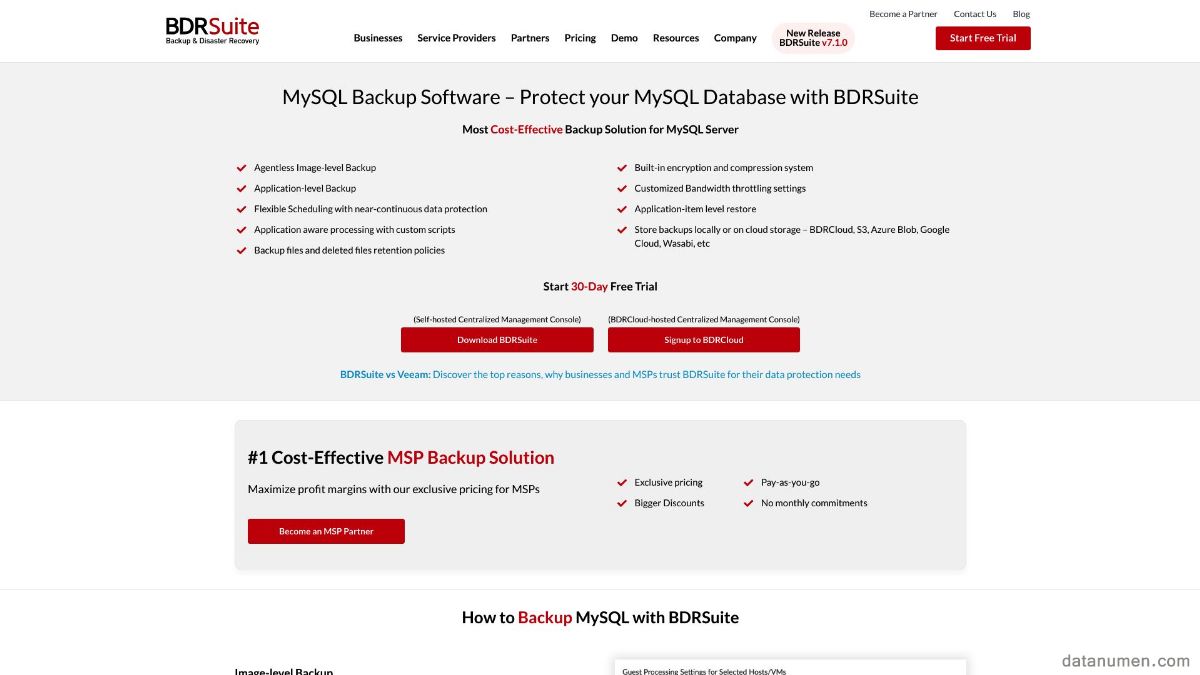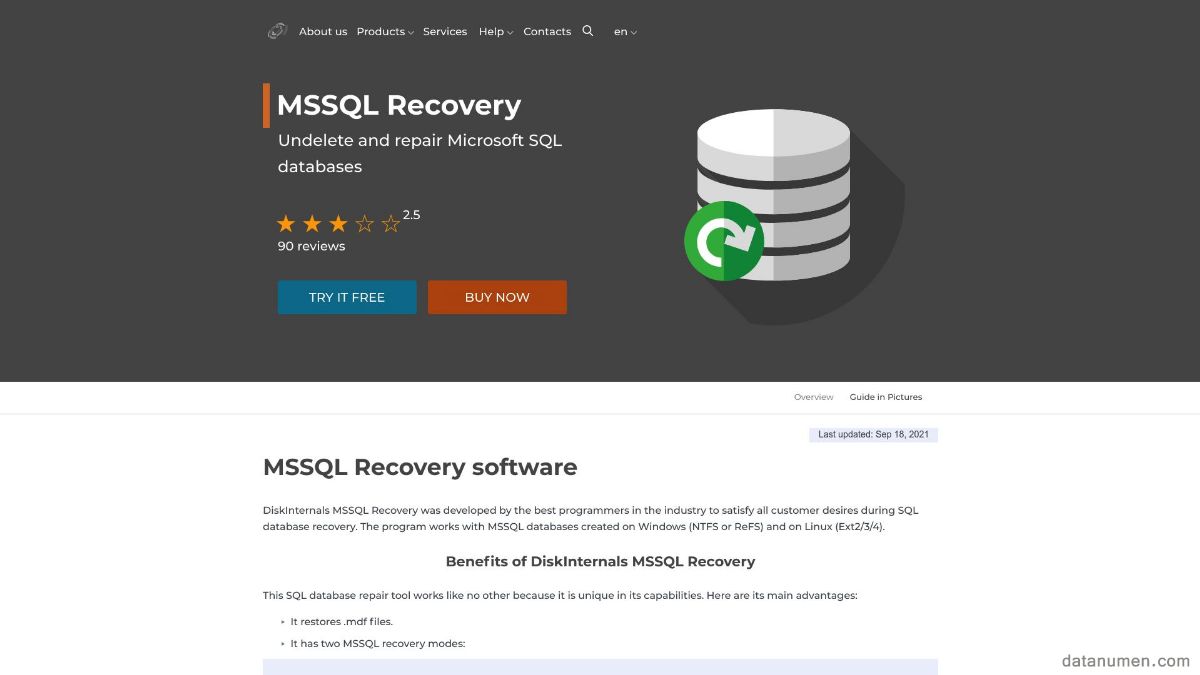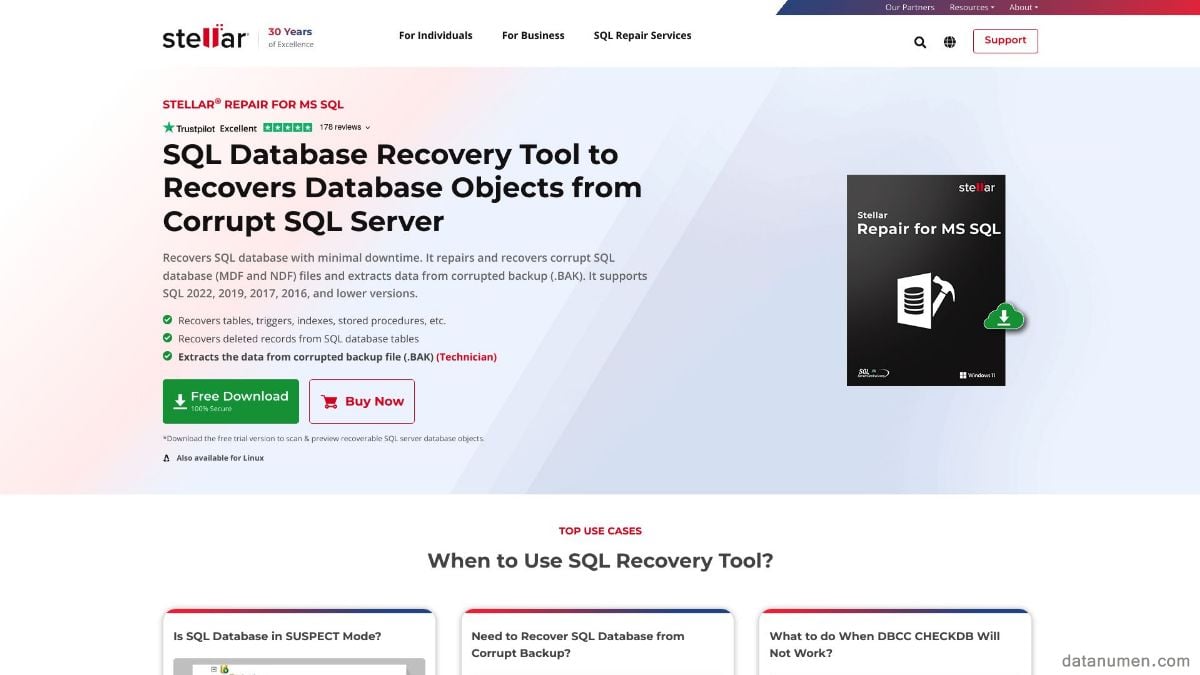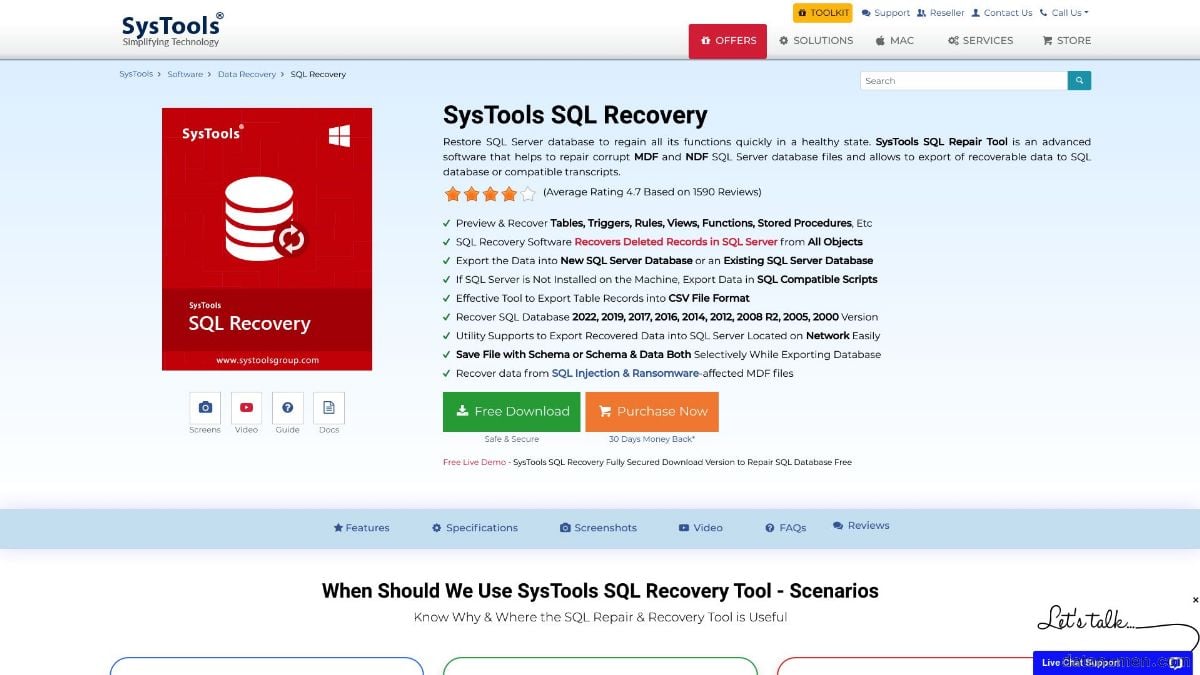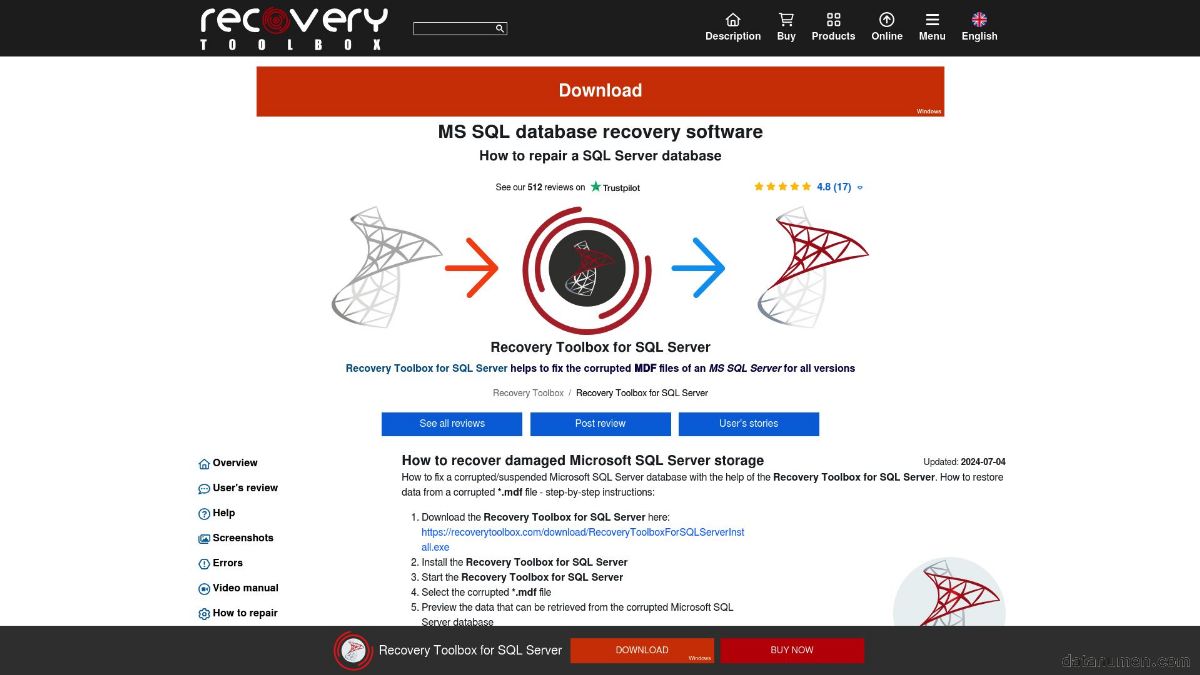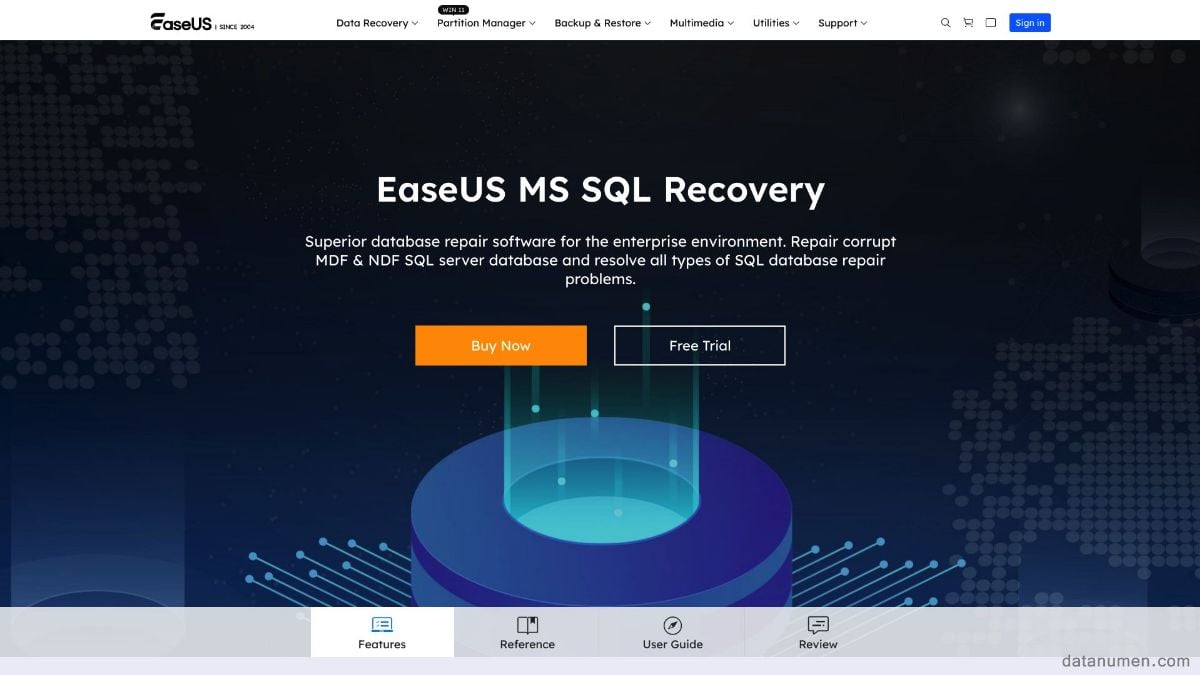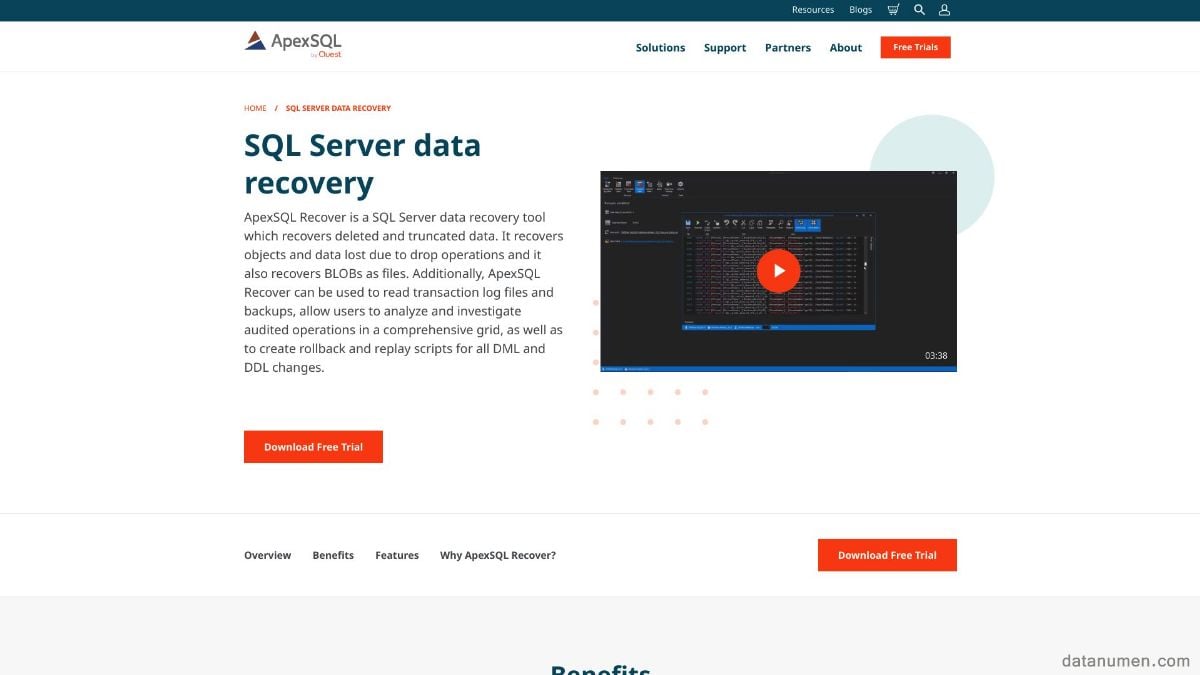1. Introduction
1.1 Importance of Database Recovery Software Tool
The integrity and availability of data are crucial to any organization. Databases serve as the backbone, housing critical information that drives business operations, customer interactions, and strategic decision-making. Unfortunately, databases are not immune to corruption, accidental deletions, or catastrophic hardware failures. When such events occur, the consequences can be dire, affecting not only data integrity but also the operational continuity and financial health of the organization.

Database recovery software tools are designed to mitigate these risks by providing robust mechanisms to restore databases to their optimal state. These tools can recover lost or corrupted data, rebuild database structures, and ensure that organizations can resume normal operations with minimal downtime. In summary, the importance of database recovery tools cannot be overstated, given their role in safeguarding critical data and maintaining business continuity.
1.2 Objectives of this Comparison
The primary objective of this comparison is to provide a detailed, unbiased evaluation of various database recovery software tools currently available in the market. By examining the strengths and weaknesses of each tool, this guide aims to assist IT professionals, database administrators, and decision-makers in selecting the most suitable recovery solution for their specific needs. This comparison will cover the following aspects:
- Features: A review of the main functionalities and capabilities of each tool.
- Pros and Cons: An analysis of the advantages and disadvantages, helping users understand the potential benefits and limitations.
- Usability: Assessment of the user interface and the overall ease of use.
- Performance: Evaluation of the tool’s efficiency and speed in performing recovery operations.
- Support and Documentation: Availability and quality of user support and documentation.
- Cost: A review of pricing models to assist in making cost-effective decisions.
Ultimately, this comparison aims to not only highlight the top-performing tools but also recommend solutions tailored to various organizational needs and budget constraints. By the end of this guide, readers should have a clear understanding of which database recovery software tool offers the best balance of features, performance, and cost-effectiveness for their specific requirements.
2. DataNumen Data Recovery
DataNumen Data Recovery is a comprehensive data recovery tool designed to retrieve lost or corrupted files and databases from various storage devices. Known for its high recovery rate and versatility, DataNumen Data Recovery supports a wide range of file formats and storage media, making it a robust solution for both personal and professional data recovery needs.
2.1 Pros
- High recovery rate: DataNumen is renowned for its industry-leading recovery rate, restoring a higher percentage of lost data compared to many competitors.
- Wide file format support: The software supports an extensive array of file formats, from standard document types to complex database files.
- User-friendly interface: The intuitive interface ensures that both novices and experienced users can navigate the recovery process with ease.
- Extensive compatibility: Compatible with various storage devices, including hard drives, memory cards, and USB drives, enhancing its utility across different scenarios.
- Advanced scanning algorithms: Utilizes sophisticated algorithms to perform deep scans and recover more data from severely corrupted files or drives.
2.2 Cons
- Cost: The software is relatively expensive compared to some other recovery tools, which may be a consideration for budget-conscious users.
- Limited support for newer file systems: Although comprehensive, DataNumen may not offer optimum support for the latest file systems or storage technologies.
- Performance on large databases: While effective, the recovery process may take significantly longer for very large databases, impacting efficiency.
- Lack of real-time support: Limited availability of real-time customer support options could hinder users who encounter immediate technical issues.
3. DataNumen SQL Recovery
DataNumen SQL Recovery is a powerful and user-friendly tool specifically designed to repair and recover corrupt or damaged SQL Server database files (MDF and NDF). It offers a streamlined process for recovering critical data and repairing database structures, making it an essential tool for database administrators and IT professionals. The software supports recovery from various types of corruption, ensuring the integrity and availability of SQL Server databases.
3.1 Pros
- User-friendly interface: Designed with simplicity in mind, the software’s intuitive interface makes it accessible for users with varying levels of technical expertise.
- Comprehensive recovery options: The tool can recover various types of data, including tables, triggers, indexes, keys, and stored procedures, offering a complete recovery solution.
- Support for large databases: Capable of handling large SQL database files effortlessly, ensuring comprehensive recovery without size limitations.
- Preview feature: Allows users to preview recovered data before saving, ensuring the accuracy and integrity of the recovery process.
- Compatibility: Supports multiple SQL Server versions, from the latest releases to older variants, providing flexibility for different user needs.
3.2 Cons
- Cost: The pricing model may be relatively high compared to similar tools, which could be a concern for smaller enterprises or individual users.
- Performance on highly corrupted files: The recovery speed may slow down significantly when dealing with severely corrupted or fragmented files, affecting efficiency.
- Limited advanced features: While comprehensive, advanced users might find the lack of some high-end features limiting for more complex recovery scenarios.
- Dependence on SQL Server: Requires a compatible SQL Server environment to execute the recovery process, which may not always be available in all situations.
4. Cigati SQL Recovery Tool
The Cigati SQL Recovery Tool is a specialized software designed to repair and restore SQL Server database files, including MDF and NDF files. It is known for its advanced recovery capabilities that cater to both minor and major corruption issues in SQL databases. The tool provides an efficient way to recover deleted database objects, minimizing data loss and maintaining the integrity of database structures. Suitable for both novice users and experts, Cigati SQL Recovery Tool ensures data retrieval in a streamlined, user-friendly manner.
4.1 Pros
- Advanced scanning modes: Offers both standard and advanced scanning options, allowing users to choose the appropriate depth of scan based on the level of corruption.
- Recovery of deleted items: Capable of restoring deleted database objects such as tables, triggers, and indexes, providing comprehensive data recovery solutions.
- Interactive user interface: Designed with an intuitive and user-friendly interface, making it easy for users to navigate through the recovery process.
- Compatibility: Supports a wide range of SQL Server versions, ensuring versatility and flexibility for users with different SQL environments.
- Preview feature: Previews recovered data before saving, allowing users to validate and verify the integrity of the recovered database objects.
4.2 Cons
- Cost: The software might be perceived as expensive for individual users or smaller businesses when compared to other recovery tools.
- Performance: Recovery speed may diminish when processing very large databases or severely corrupted files, impacting overall efficiency.
- Limited format support: Primarily focused on SQL databases, which may limit its utility for users needing to recover other types of database formats.
- Dependency on SQL Server: Requires an SQL Server environment for execution, which may pose a challenge for users without immediate access to a server setup.
5. DBR for Oracle
DBR for Oracle is an advanced database recovery software specifically designed for Oracle databases. It focuses on repairing and restoring corrupted Oracle database files, ensuring data integrity and minimizing downtime. The tool offers a comprehensive set of features tailored to handle various corruption scenarios, making it an essential utility for database administrators managing Oracle environments. DBR for Oracle is equipped to deal with both logical and physical data corruption, providing a robust solution for maintaining the health of Oracle databases.
5.1 Pros
- Specialized for Oracle: Specifically designed for Oracle database recovery, ensuring high compatibility and effectiveness in handling Oracle-specific corruption issues.
- Advanced recovery algorithms: Utilizes sophisticated algorithms that can handle both logical and physical corruption, offering a thorough recovery process.
- User-friendly interface: Features an intuitive interface that simplifies the recovery process, making it accessible for users with varying levels of technical expertise.
- Data integrity: Ensures the integrity of the restored data, minimizing the risk of data loss and preserving the consistency of the database structure.
- Wide version support: Compatible with multiple versions of Oracle database, providing flexibility for users working with different Oracle environments.
5.2 Cons
- Cost: The software can be relatively expensive, which may be a concern for smaller organizations or individual users with limited budgets.
- Performance with large databases: Recovery speed may be slower when processing very large databases, potentially impacting operational efficiency.
- Limited to Oracle: Exclusively focused on Oracle databases, which may not be suitable for users requiring multi-database recovery solutions.
- Dependency on Oracle environment: Requires an Oracle database environment for recovery operations, which might be a limitation if immediate access to such an environment is unavailable.
6. BDRSuite
BDRSuite is a comprehensive backup and disaster recovery solution designed to protect MySQL databases, among others. It offers a versatile platform for backing up, restoring, and managing database data with ease. This tool supports various backup methods, including full, incremental, and differential backups, ensuring that data is regularly secured and can be quickly restored in the event of data loss or corruption. BDRSuite is aimed at both small and large enterprises, providing a scalable solution for ensuring database continuity and reliability.
6.1 Pros
- Versatile backup options: Supports multiple backup types, including full, incremental, and differential, providing flexibility in backup strategies.
- High-speed recovery: Designed to perform quick recovery operations, minimizing downtime and ensuring data availability.
- User-friendly interface: Features an intuitive and easy-to-navigate interface, making it accessible for users with varying levels of expertise.
- Scalability: Easily scalable to meet the needs of both small businesses and large enterprises, adapting to growth and changing requirements.
- Automated scheduling: Offers automation features for scheduling regular backups, reducing manual intervention and ensuring consistent data protection.
6.2 Cons
- Cost: The pricing model may be a concern for smaller businesses or individual users who require a budget-friendly solution.
- Complex setup: Initial setup and configuration can be complex, potentially requiring technical expertise to fully utilize its capabilities.
- Resource-intensive: May consume significant system resources during backup and recovery operations, potentially affecting system performance.
- Limited to MySQL and certain databases: Primarily focused on MySQL databases, which may limit its utility for users needing multi-database recovery solutions.
7. DiskInternals MSSQL Recovery
DiskInternals MSSQL Recovery is a specialized tool designed to repair and recover Microsoft SQL Server database files, including MDF and NDF files. The software is acclaimed for its ability to handle various types of corruption, ensuring the retrieval of data in its original form. Its powerful features make it a preferred choice for database administrators who need a reliable solution for SQL Server database recovery. The tool is equipped to deal with common issues such as file damage, accidental deletions, and data corruption, providing a comprehensive recovery solution for SQL Server environments.
7.1 Pros
- High recovery rate: Known for its high success rate in recovering lost or corrupted data from SQL Server databases.
- Advanced repair algorithms: Utilizes sophisticated algorithms to repair database files, ensuring thorough and accurate recovery.
- User-friendly interface: Features an intuitive, easy-to-use interface that simplifies the recovery process, even for users with limited technical knowledge.
- Preview feature: Offers a preview of recoverable data before final restoration, allowing users to verify the integrity of the recovered data.
- Compatibility: Supports a wide range of SQL Server versions, providing flexibility for users operating in different SQL environments.
7.2 Cons
- Cost: The software can be relatively expensive, which might be a concern for individual users or small organizations with tight budgets.
- Performance on large databases: Recovery processes may slow down when dealing with very large databases, potentially affecting efficiency and productivity.
- Resource-intensive: May require significant system resources during recovery operations, which could impact the performance of other running applications.
- Limited to MSSQL: Designed exclusively for Microsoft SQL Server databases, which may not be suitable for users needing multi-database recovery solutions.
8. STELLAR REPAIR FOR MS SQL
STELLAR REPAIR FOR MS SQL is a powerful tool designed specifically for the recovery of corrupted or damaged Microsoft SQL Server database files (MDF and NDF). Known for its reliability and effectiveness, the software can repair and restore databases affected by corruption due to various reasons such as hardware failure, software bugs, and accidental deletions. STELLAR REPAIR FOR MS SQL is equipped with features that ensure minimal data loss and maintain the integrity of the restored database, making it a trusted choice for database administrators and IT professionals.
8.1 Pros
- Comprehensive recovery capabilities: Recovers a wide array of database objects, including tables, indexes, views, stored procedures, and triggers, ensuring complete data restoration.
- Compatibility: Supports various versions of SQL Server, providing flexibility and versatility for users working in different SQL environments.
- User-friendly interface: Features an intuitive and easy-to-navigate interface, making the recovery process straightforward even for users with limited technical expertise.
- Preview feature: Allows users to preview recoverable data before saving, ensuring the accuracy and integrity of the recovered database objects.
- Selective recovery: Offers the ability to selectively recover specific database objects, adding convenience and efficiency to the recovery process.
8.2 Cons
- Cost: The software may be considered expensive, particularly for smaller businesses or individual users with constrained budgets.
- Resource-intensive: Recovery operations can be resource-intensive, potentially affecting the performance of the system or other applications running concurrently.
- Performance on severely corrupted files: The recovery speed may decrease significantly when dealing with severely corrupted or very large database files.
- Limited multi-database support: Primarily focused on MS SQL Server, which might not be suitable for users needing recovery solutions for multiple database systems.
9. SysTools SQL Recovery
SysTools SQL Recovery is a robust software solution designed to repair and recover corrupted SQL Server database files, including MDF and NDF files. It is used by database administrators and IT professionals to mitigate data loss and restore database integrity following database corruption. The software provides a straightforward recovery process and supports a wide range of SQL Server versions, making it a versatile tool for various SQL recovery scenarios. SysTools SQL Recovery ensures that data is retrieved accurately and efficiently, preserving the functionality and consistency of SQL Server databases.
9.1 Pros
- Wide compatibility: Supports multiple versions of SQL Server, enhancing its versatility and usability across different SQL environments.
- Comprehensive data recovery: Recovers a broad range of database objects, including tables, triggers, views, indexes, and stored procedures, ensuring complete database restoration.
- User-friendly interface: Features an intuitive interface, making the recovery process accessible and easy to navigate for users of all technical levels.
- Preview functionality: Allows users to preview recoverable data before performing the final restoration, ensuring data accuracy and integrity.
- Selective recovery option: Provides the ability to selectively recover specific database objects, adding convenience and efficiency to the recovery process.
9.2 Cons
- Cost: The software may be perceived as expensive for individuals or small businesses with limited budgets.
- Performance with large databases: The recovery process can be time-consuming when dealing with very large or severely corrupted database files, potentially impacting productivity.
- Resource consumption: Recovery operations may require significant system resources, which can affect the performance of other applications running concurrently.
- Limited to SQL Server: Focuses exclusively on SQL Server databases, which may not meet the needs of users who require recovery solutions for multiple database systems.
10. Recovery Toolbox for SQL Server
Recovery Toolbox for SQL Server is a specialized software tool designed to recover data from corrupted Microsoft SQL Server database files, including MDF and NDF files. The tool focuses on repairing database structures and retrieving as much data as possible, thereby minimizing data loss and restoring database functionality. It is an essential utility for database administrators and IT professionals who need an effective solution to handle SQL Server database corruption issues. Recovery Toolbox for SQL Server provides an intuitive user interface, making the recovery process straightforward and accessible.
10.1 Pros
- High recovery success rate: Known for its ability to recover a significant amount of data from corrupted SQL Server databases, ensuring minimal data loss.
- Ease of use: Features a user-friendly, intuitive interface that makes the recovery process simple and accessible, even for users with limited technical expertise.
- Compatibility: Supports a wide range of SQL Server versions, providing flexibility and versatility for different database environments.
- Step-by-step recovery: Offers a guided, step-by-step recovery process, helping users navigate through the recovery procedures effectively.
- Preview function: Allows users to preview recoverable data before performing the final restoration, ensuring the integrity and accuracy of the recovered database objects.
10.2 Cons
- Cost: The software can be relatively expensive, which may be a concern for smaller organizations or individuals with limited budgets.
- Performance on large databases: Recovery processes may slow down when dealing with very large or severely corrupted database files, potentially affecting efficiency.
- Resource-intensive: The tool may require significant system resources during recovery operations, which could impact the performance of other applications running concurrently.
- Limited to SQL Server: Designed exclusively for Microsoft SQL Server databases, which may not be suitable for users who require recovery solutions for multiple database systems.
11. EaseUS MS SQL Recovery
EaseUS MS SQL Recovery is a robust software solution specifically designed to recover and repair corrupted Microsoft SQL Server database files, including MDF and NDF files. The tool is praised for its user-friendly interface and powerful recovery capabilities, making it an indispensable utility for database administrators and IT professionals. With its advanced algorithms, EaseUS MS SQL Recovery can handle various corruption scenarios, ensuring business continuity by restoring critical database data swiftly and accurately.
11.1 Pros
- User-friendly interface: The software’s interface is intuitive and easy to navigate, making the recovery process straightforward for users of all technical levels.
- High recovery rate: Known for its high success rate in recovering data from corrupted SQL Server databases, ensuring minimal data loss.
- Comprehensive recovery options: Capable of recovering a wide range of database objects, such as tables, triggers, views, indexes, and stored procedures, providing a complete recovery solution.
- Preview feature: Offers a preview of recoverable data before the final restoration, allowing users to verify the integrity and accuracy of the retrieved data.
- Compatibility: Supports multiple versions of SQL Server, providing flexibility and adaptability for different SQL environments.
11.2 Cons
- Cost: The pricing may be considered high, particularly for smaller businesses or individual users with limited budgets.
- Resource-intensive: The recovery operations may require significant system resources, which can impact the performance of other applications running concurrently.
- Performance on large databases: The recovery process may be slower when handling very large or severely corrupted database files, potentially affecting operational efficiency.
- Limited to SQL Server: Exclusively focused on Microsoft SQL Server databases, which may not be suitable for users needing multi-database recovery solutions.
12. ApexSQL Recover
ApexSQL Recover is a specialized database recovery tool designed to recover lost, deleted, or corrupted data from Microsoft SQL Server databases. It supports a wide array of data recovery operations, including recovering deleted, truncated, or dropped tables, and restoring data from database backups. The software is equipped with advanced recovery features and an intuitive interface, making it a valuable asset for database administrators aiming to ensure data integrity and minimize downtime. ApexSQL Recover is compatible with various versions of SQL Server, offering flexibility and reliability for diverse recovery scenarios.
12.1 Pros
- Wide array of recovery options: Capable of recovering deleted, truncated, or dropped tables, and can restore data from backups, providing comprehensive recovery capabilities.
- User-friendly interface: The intuitive and well-organized interface simplifies the recovery process, making it accessible for users with different levels of technical expertise.
- High compatibility: Supports multiple versions of SQL Server, offering flexibility and adaptability for different SQL environments.
- Advanced recovery features: Equipped with advanced features that ensure thorough and accurate data recovery, enhancing the reliability of the recovery process.
- Data preview: Allows users to preview the recoverable data before performing the final restoration, ensuring the accuracy and integrity of the recovered information.
12.2 Cons
- Cost: The software may be expensive for smaller businesses or individual users with limited budgets, making it less accessible for some potential users.
- Resource-intensive: Recovery operations can be resource-intensive, potentially affecting the performance of the system and other running applications.
- Complex setup: Initial setup and configuration may be complex, potentially requiring technical expertise to fully leverage the software’s capabilities.
- Limited to SQL Server: Focused exclusively on Microsoft SQL Server databases, which may not be suitable for users who require multi-database recovery solutions.
13. Summary
13.1 Top Choice
After comprehensive comparison, we select DataNumen Data Recovery as the top choice, due to its high performance and easy to use GUI.
13.2 Overall Comparison Table
| Tool | Features | Ease of Use | Price | Customer Support |
|---|---|---|---|---|
| DataNumen Data Recovery | High recovery rate, wide file format support, advanced scanning algorithms | High | Moderate | Excellent |
| DataNumen SQL Recovery | Comprehensive recovery options, supports large databases | High | High | Excellent |
| Cigati SQL Recovery Tool | Advanced scanning modes, recovery of deleted items | High | Moderate | Good |
| DBR for Oracle | Specialized for Oracle, advanced recovery algorithms | High | High | Good |
| BDRSuite | Versatile backup options, high-speed recovery | Moderate to High | Moderate to High | Good |
| DiskInternals MSSQL Recovery | High recovery success rate, advanced repair algorithms | High | High | Good |
| STELLAR REPAIR FOR MS SQL | Comprehensive recovery capabilities, selective recovery | High | Moderate to High | Good |
| SysTools SQL Recovery | Wide compatibility, comprehensive data recovery | High | Moderate | Good |
| Recovery Toolbox for SQL Server | High recovery success rate, step-by-step recovery | High | Moderate | Average |
| EaseUS MS SQL Recovery | High recovery rate, comprehensive recovery options | High | Moderate to High | Good |
| ApexSQL Recover | Wide range of recovery options, advanced recovery features | High | Moderate to High | Good |
13.3 Recommended Tool Based on Various Needs
Choosing the right database recovery tool depends on specific organizational requirements, including budget constraints, ease of use, feature richness, and the need for customer support. Here are some recommendations based on varying needs:
- Best Overall Performance: DataNumen Data Recovery is recommended for its high recovery rate and extensive file format support, making it suitable for a wide range of recovery scenarios.
- Best for SQL Server: DataNumen SQL Recovery comes highly recommended for its comprehensive recovery capabilities and ease of use, ideal for SQL Server environments.
- Best for Oracle Databases: DBR for Oracle is the go-to choice given its specialized recovery features tailored specifically for Oracle databases.
- Budget-Friendly Option: SysTools SQL Recovery offers reliable performance at a more affordable price point, making it an excellent option for smaller businesses.
- Most Versatile Backup Solution: BDRSuite is recommended for its versatile backup options and high-speed recovery, suitable for organizations seeking comprehensive backup and recovery solutions.
14. Conclusion
14.1 Final Thoughts and Takeaways for Choosing a Database Recovery Software Tool
In an era where data is a critical asset for any organization, having a reliable database recovery software tool is indispensable. The choice of the right tool can mean the difference between minimal operational disruption and severe data loss affecting business continuity.
When choosing a database recovery software tool, consider the following key factors:
- Features: Evaluate the recovery capabilities and features offered by each tool. Ensure it can handle the specific types of data and database structures used in your organization. Advanced features such as support for multiple database objects, comprehensive backup options, and selective recovery can add significant value.
- Ease of Use: The user interface and overall usability of the software are crucial. A tool with an intuitive interface and easy navigation will facilitate quicker recovery operations, especially for users with limited technical expertise.
- Performance and Efficiency: Consider the performance aspects of the tool, especially its recovery speed and efficiency in handling large or severely corrupted databases. Tools with advanced scanning algorithms tend to provide better performance and higher success rates.
- Compatibility: Ensure that the software is compatible with the versions of the database management systems you are using. Wider compatibility provides flexibility to adapt to different database environments.
- Customer Support: Reliable customer support can make a significant difference, especially when facing complex recovery scenarios. Evaluate the availability, responsiveness, and quality of customer support services offered by the software provider.
- Cost: Consider your budget constraints and evaluate the cost-effectiveness of the tool. While some tools may be more expensive, they often come with advanced features and better performance that can justify the investment.
No single tool is perfect for every situation; the best choice depends on your specific needs and circumstances. For SQL Server environments, DataNumen SQL Recovery stand out for their comprehensive recovery capabilities. For Oracle databases, DBR for Oracle is highly recommended. If budget is a primary concern, SysTools SQL Recovery offers a balanced combination of features and affordability.
Ultimately, investing in a robust database recovery software tool is not just about mitigating risks; it is about ensuring the continuity and resilience of your business operations. By carefully considering the factors outlined above, you can select a tool that best meets your needs and provides peace of mind knowing that your critical data can be recovered swiftly and reliably.
Author Introduction:
Vera Chen is a data recovery expert in DataNumen, which provides a wide range of products, including a powerful tool to fix PDF documents.
